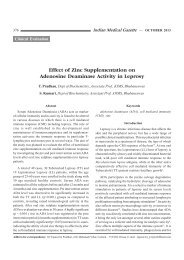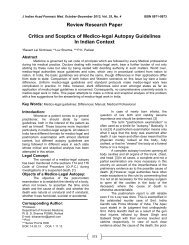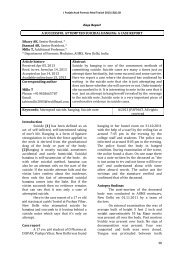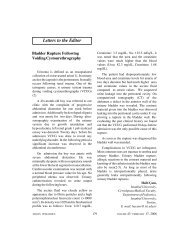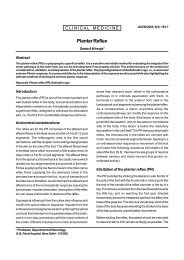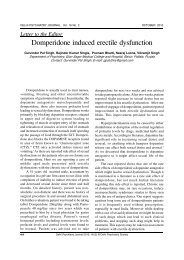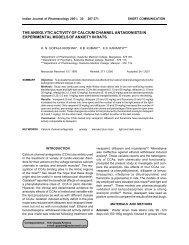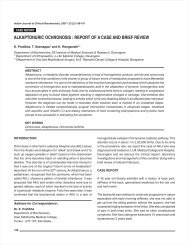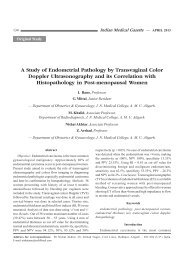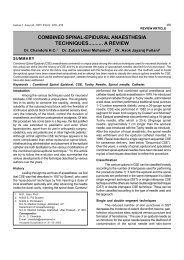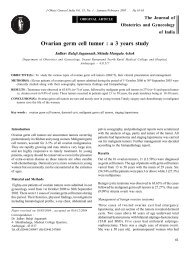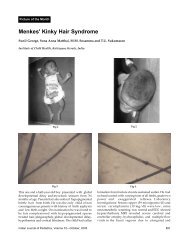Double Giant Lambl's Excrescence of aortic valve causing ... - medIND
Double Giant Lambl's Excrescence of aortic valve causing ... - medIND
Double Giant Lambl's Excrescence of aortic valve causing ... - medIND
You also want an ePaper? Increase the reach of your titles
YUMPU automatically turns print PDFs into web optimized ePapers that Google loves.
Indian J Thorac Cardiovasc Surg (Jan–March 2011) 27:36–38<br />
DOI 10.1007/s12055-010-0062-4<br />
CASE REPORT<br />
<strong>Double</strong> <strong>Giant</strong> Lambl’s <strong>Excrescence</strong> <strong>of</strong> <strong>aortic</strong> <strong>valve</strong> <strong>causing</strong><br />
posterior circulation stroke<br />
Vijayakumar Raju & Muralidharan Srinivasan & Chandrasekar Padmanaban &<br />
Venkatadevanathan Muthubaskaran & Rajpal Kanaklal Abhaichand<br />
Received: 31 October 2009 /Accepted: 21 November 2010 /Published online: 30 December 2010<br />
# Indian Association <strong>of</strong> Cardiovascular-Thoracic Surgeons 2010<br />
Abstract Diagnostic evaluation <strong>of</strong> embolic neurologic<br />
events requires the consideration <strong>of</strong> cardiac causes. Lambl’s<br />
<strong>Excrescence</strong>s (LE)are filiform fronds that occur at sites <strong>of</strong><br />
valvular closure due to “wear and tear” (Lambl Wien Med<br />
Wschr 6:244–247, 1856). The complex form <strong>of</strong> LE is<br />
“giant Lambl’s <strong>Excrescence</strong>s” which results from the<br />
adherence <strong>of</strong> multiple adjacent excrescences that grow<br />
large. We recently had young male adult who presented<br />
with features <strong>of</strong> posterior circulation stroke (basilar) and<br />
detected to have two separate giant Lambl’s <strong>Excrescence</strong>s<br />
on the <strong>aortic</strong> <strong>valve</strong> and treated successfully.<br />
Keywords Aortic <strong>valve</strong> . Computed tomography . Stroke<br />
V. Raju : M. Srinivasan (*) : C. Padmanaban : V. Muthubaskaran<br />
Department <strong>of</strong> Cardiovascular and Thoracic Surgery,<br />
G. Kuppuswamy Naidu Memorial Hospital,<br />
Coimbatore, Tamilnadu, India<br />
e-mail: drmurali@vsnl.com<br />
V. Raju<br />
e-mail: vijraju@hotmail.com<br />
C. Padmanaban<br />
e-mail: chanpad@gmail.com<br />
V. Muthubaskaran<br />
e-mail: Venkatvision2020@yahoo.com<br />
R. K. Abhaichand<br />
Department <strong>of</strong> Cardiology,<br />
G. Kuppuswamy Naidu Memorial Hospital,<br />
Coimbatore, Tamilnadu, India<br />
e-mail: drrajpal@yahoo.com<br />
Case report<br />
44 years old male who is a chronic smoker, presented with<br />
history <strong>of</strong> sudden onset <strong>of</strong> left sided neck pain associated<br />
with bilateral visual disturbance in the form <strong>of</strong> blurring and<br />
diplopia since 2 days. There was no history <strong>of</strong> cardiac<br />
symptoms, fever, motor or sensory deficit. He was<br />
evaluated by the neurologist at local hospital and Computed<br />
tomography showed small infarct in the posterior watershed<br />
area. Electrocardiogram (ECG) showed “T” wave inversion<br />
in anterior chest leads, hence he was refered to our<br />
cardiology department.<br />
On evaluation his systemic blood pressure was 170/<br />
110 mm hg and had diplopia on both eyes . Neurological<br />
and cardiovascular examination was otherwise<br />
normal. His basic biochemical investigations including<br />
markers for acute coronary syndrome were within<br />
normal limits. Chest roentgenogram revealed normal<br />
cardiac and lung shadows. ECG showed T wave<br />
inversion in anterior chest leads. Transthoracic echocardiogram<br />
showed suspicious <strong>of</strong> Aortic <strong>valve</strong> mass with<br />
mild <strong>aortic</strong> regurgitation with mild left ventricular<br />
dysfunction. Transesophageal echocardiogram showed<br />
17×11 mm sessile mass attached to the inferior aspect<br />
<strong>of</strong> Right Coronary Cusp (RCC) and its base extends to<br />
interventricular septum. An additional mass 24×10 mm<br />
attached to the Left ventrricular aspect <strong>of</strong> Left Coronary<br />
Cusp (LCC) (Fig. 1). No evidence <strong>of</strong> <strong>aortic</strong> stenosis or<br />
<strong>aortic</strong> regurgitation.<br />
Based on the above findings we assumed that his clinical<br />
presentation was secondary to embolization <strong>of</strong> <strong>aortic</strong> <strong>valve</strong><br />
mass in to the posterior cerebral circulation. Conventional<br />
coronary angiogram was deferred in the view <strong>of</strong> <strong>aortic</strong><br />
<strong>valve</strong> mass. 128 slice coronary computerized tomogram
Indian J Thorac Cardiovasc Surg (Jan–March 2011) 27:36–38 37<br />
Fig. 1 TEE showing “double <strong>Giant</strong> Lambl’s excrescence” attached to<br />
left and right coronary cusp <strong>of</strong> <strong>aortic</strong> <strong>valve</strong><br />
revealed normal coronary arteries. He was taken up for<br />
excision <strong>of</strong> <strong>aortic</strong> <strong>valve</strong> tumor.<br />
Surgery was carried via midline sternotomy and went on<br />
Cardiopulmonary bypass by using <strong>aortic</strong> and two stage<br />
single RA venous cannula. Left ventricle was vented<br />
through right superior pulmonary vein. After cross clamping<br />
the aorta, transverse aortotomy was made and heart was<br />
arrested with osteal cardioplegia. Aortic outflow was almost<br />
completely occluded by two separate papillomatous lesion<br />
arising from inferior aspect <strong>of</strong> LCC and RCC and each<br />
lesion measuring about 1.5×1.5 cm and their attachment<br />
was extending to the Interventricular septum. Aortic surface<br />
<strong>of</strong> the Leaflets were free. Coronary ostia was normal. Both<br />
<strong>aortic</strong> cusps were retracted and both lesion were shaved <strong>of</strong>f<br />
from the cusps (Fig. 2). Aortic leaflets were preserved fully.<br />
On table Transesophageal echocardiogram showed no<br />
Fig. 2 Totally excised specimen <strong>of</strong> Lambl’s excrescence <strong>of</strong> <strong>aortic</strong><br />
<strong>valve</strong> without any damage to the Aortic cusps<br />
Fig. 3 Postoperative TEE showing no residual lesion with normal<br />
coaptation <strong>of</strong> <strong>aortic</strong> <strong>valve</strong><br />
residual lesion with good <strong>valve</strong> coaptation with no <strong>aortic</strong><br />
regurgitation (Fig. 3). He had uneventful postoperative<br />
period. Histopathology confirmed that the lesion was <strong>Giant</strong><br />
Lambl’s <strong>Excrescence</strong> <strong>of</strong> <strong>aortic</strong> <strong>valve</strong>. He had persistent<br />
diplopia and mild visual blurring, but no new neurological<br />
deficit. He was discharged on antiplatelets. His diplopia<br />
was disappeared in 6 weeks following surgery.<br />
Discussion<br />
Lambl’s excrescences were first described by Vile’m Dusan<br />
Lambl, a Bohemian physician in 1859. Lambl described<br />
small filiform projections(Lambl’s excrescences) on the<br />
cusps <strong>of</strong> <strong>aortic</strong> <strong>valve</strong>s in 2% <strong>of</strong> 1,000 autopsies [1]. They<br />
may found without any other evidence <strong>of</strong> cardiac disease.<br />
They are more commonly seen on the mitral <strong>valve</strong> than on<br />
the <strong>aortic</strong> <strong>valve</strong>, typically near the closure line <strong>of</strong> mitral<br />
<strong>valve</strong>. They originate as small thrombi on endocardial<br />
surfaces where <strong>valve</strong> margins make contact. These are the<br />
sites <strong>of</strong> minor endothelial damage, due to wear and tear [2].<br />
In atrioventricular <strong>valve</strong>s, LE are found at the site <strong>of</strong> <strong>valve</strong><br />
closure. In semilunar <strong>valve</strong>s, they can occur anywhere on<br />
the <strong>valve</strong>. These lesions are broder and multiple.<br />
The Complex form <strong>of</strong> LE is “giant LE”, which results<br />
from the adherence <strong>of</strong> multiple adjacent excrescences that<br />
grow large [3, 4]. LE are a fairly rare disease entity. <strong>Giant</strong><br />
LE are still very rare entity. Only one case report<br />
mentioning about <strong>Giant</strong> LE presenting with embolus to<br />
the popliteal artery embolus [5]. No literature is available<br />
about “double <strong>Giant</strong> LE” in <strong>aortic</strong> <strong>valve</strong> for best our<br />
knowledge .<br />
Their papillary structure, with loose, friable projections,<br />
results in a high tendency for embolism. Tumor
38 Indian J Thorac Cardiovasc Surg (Jan–March 2011) 27:36–38<br />
fragments <strong>of</strong>ten embolize to the coronary, systemic, or<br />
cerebral arterial systems. Quinson ‘s group described a<br />
case <strong>of</strong> LE <strong>causing</strong> obstruction <strong>of</strong> right coronary ostium<br />
in a 64 year old women with angina [6]. Earlier reports<br />
have mentioned that LE are usually an uncommon cause<br />
<strong>of</strong> cerebral embolism [7]. No literature is available about<br />
LE <strong>causing</strong> posterior circulation stroke from best <strong>of</strong> our<br />
knowledge.<br />
Transesophageal Echocardiogram(TEE) is very useful in<br />
identifying valvular strands in patients with suspected<br />
cardiogenic embolic stroke. . Valve strands were reported<br />
in 39%<strong>of</strong> elderly patients who had TEE for suspected<br />
cardiogenic embolic stroke [8]. The distinction between<br />
papillary fibroelastoma and Lambl’s excrescence was<br />
particularly difficult. Papillary Fibroelastoma (PFE) typically<br />
appears on echocardiography as a small pedunculated,<br />
homogenous, well-demonstrated mobile mass attached by a<br />
small stalk. Although these findings may be applied to the<br />
Lambl’s excrescence, the stalk <strong>of</strong> papillary fibroelastoma<br />
has a broader base than LE.<br />
Histologically, LEs are avascular, and <strong>of</strong>ten acellular<br />
with a hyaline core. Most patients with LE are asympotamatic.<br />
However <strong>aortic</strong> <strong>valve</strong> lesions can break and<br />
embolize. TEE should be included as essential part <strong>of</strong><br />
evaluation <strong>of</strong> any stroke. Any features <strong>of</strong> distal emboliza-<br />
tion, is an indication for surgical removal. Asymptomatic<br />
patients should be monitored very closely.<br />
References<br />
1. Lambl VA. Papillare exkreszenzen an der semilunar-klappe der<br />
aorta. Wien Med Wschr. 1856;6:244–7.<br />
2. Aziz F, Baciewicz Jr FA. Lambl’s <strong>Excrescence</strong>s.review and<br />
recommendations. Tex Heart Inst J. 2007;34:366–8.<br />
3. Shirani M, Bradlow M, Metveyeva P, et al. Transient loss <strong>of</strong> vision<br />
as the presenting symptoms <strong>of</strong> papillary fibroelastoma <strong>of</strong> <strong>aortic</strong><br />
<strong>valve</strong>- two dimentional echocardiographic recognition. Cardiovasc<br />
Pathol. 1997;6:237–40.<br />
4. Bhagwandien NS, Shah N, Costello Jr JM, Gilbert CL, Blankenship<br />
JC. Echocardiographic detection <strong>of</strong> pulmonary <strong>valve</strong> papillary<br />
fibroelstoma. J Cardiovasc Surg. 1998;39:351–4.<br />
5. Fitzgerald D, Gaffney P, Dervan P, Doyle CT, Horgan J, Nelligan<br />
M. <strong>Giant</strong> Lambl’ s excrescences presenting as a peripheral<br />
embolus. Chest. 1982;81:516–7.<br />
6. Quinson P, de Gevigney G, Boucher F, et al. Fibrous <strong>aortic</strong> <strong>valve</strong><br />
tumor (Lambl’s excrescence) trapped in right coronary artery.<br />
Apropos <strong>of</strong> a case. Arch Mal Coeur Vaiss. 1996;89:1419–23.<br />
7. Nighoghossian N, Trouillas P, Perinetti M, Barthelet M, Ninet J,<br />
Loire R. Lambl’s excrescence: an uncommon cause <strong>of</strong> cerebral<br />
embolism. Rev Neurol (Paris). 1995;151:583–5.<br />
8. Nakahira J, Sawai T, Katsumata T, Imanaka H, Minami T. Lambl’s<br />
<strong>Excrescence</strong> on <strong>aortic</strong> <strong>valve</strong> detected by transesophageal echocardiography.<br />
Anasth Analg. 2008;106:1639–40.



